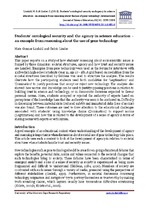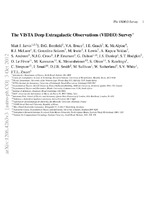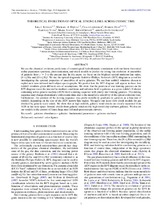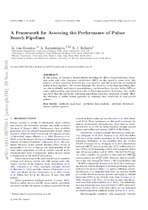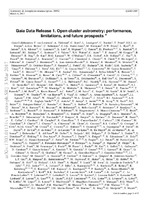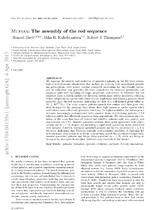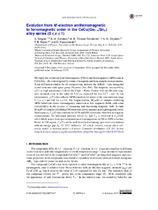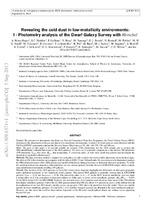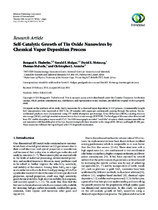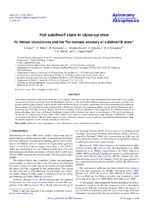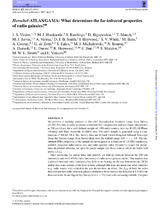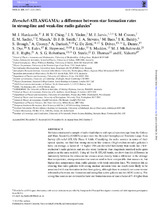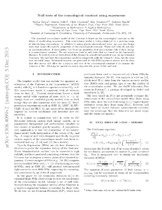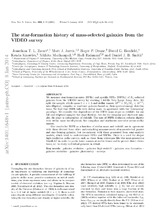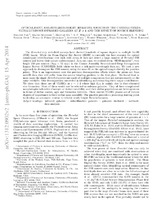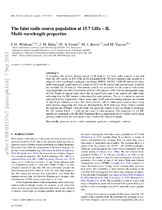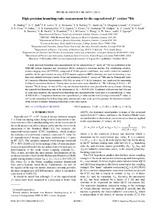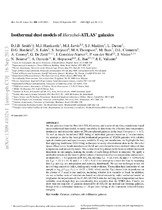Physics and Astronomy: Recent submissions
Now showing items 501-520 of 533
-
Students' ontological security and agency in science education - an example from reasoning about the use of gene technology
(Taylor & Francis, 2013)This paper reports on a study of how students' reasoning about socioscientific issues is framed by three dynamics: societal structures, agency and how trust and security issues are handled. Examples from gene technology ... -
The VISTA Deep Extragalactic Observations (VIDEO) survey
(Oxford University Press, 2013)In this paper we describe the first data release of the the Visible and Infrared Survey Telescope for Astronomy (VISTA) Deep Extragalactic Observations (VIDEO) survey. VIDEO is a 12 degree2 survey in the near-infrared ... -
Theoretical evolution of optical strong lines across cosmic time
(The American Astronomical Society, 2013)We use the chemical evolution predictions of cosmological hydrodynamic simulations with our latest theoretical stellar population synthesis, photoionization, and shock models to predict the strong line evolution of ... -
A framework for assessing the performance of pulsar search pipelines
(Oxford Unviersity Press, 2016)In this paper, we present a framework for assessing the effect of non-stationary Gaussian noise and radio frequency interference (RFI) on the signal to noise ratio, the number of false positives detected per true positive ... -
Gaia Data Release 1. Open cluster astrometry: performance, limitations, and future prospects
(EDP Sciences, 2017)CONTEXT: The first Gaia Data Release contains the Tycho-Gaia Astrometric Solution (TGAS). This is a subset of about 2 million stars for which, besides the position and photometry, the proper motion and parallax are ... -
Mufasa: The assembly of the red sequence
(Oxford University Press, 2017)We examine the growth and evolution of quenched galaxies in the Mufasa cosmo- logical hydrodynamic simulations that include an evolving halo mass-based quench- ing prescription, with galaxy colours computed accounting ... -
Evolution from 4f-electron antiferromagnetic to ferromagnetic order in the CeCu(Ge1-xSnx) alloy series (0≤x≤1)
(American Institute of Physics Inc., 2017)We report the evolution from ferromagnetic (FM) to antiferromagnetic (AFM) state in CeCu(Ge1-xSnx) investigated by means of magnetic and heat capacity measurements. X-ray diffraction studies for all compositions indicate ... -
Revealing the cold dust in low-metallicity environments: I. Photometry analysis of the Dwarf Galaxy Survey with Herschel
(EDP Sciences, 2013)Context. We present new photometric data from our Herschel Guaranteed Time Key Programme, the Dwarf Galaxy Survey (DGS), dedicated to the observation of the gas and dust in low-metallicity environments. A total of 48 ... -
Existence domains of dust-acoustic solitons and supersolitons
(AIP PublishingAIP Publishing, 2013)Using the Sagdeev potential method, the existence of large amplitude dust-acoustic solitons and supersolitons is investigated in a plasma comprising cold negative dust, adiabatic positive dust, Boltzmann electrons, and ... -
Self-catalytic growth of tin oxide nanowires by chemical vapor deposition process
(Hindawi, 2013)We report on the synthesis of tin oxide (SnO2) nanowires by a chemical vapor deposition (CVD) process. Commercially bought SnO nanopowders were vaporized at 1050∘C for 30 minutes with argon gas continuously passing through ... -
Hot subdwarf stars in close-up view IV. Helium abundances and the 3He isotopic anomaly of subdwarf B stars
(EDP Sciences, 2013)Atmospheric parameters and helium abundances of 44 bright subdwarf B stars have been determined. More than half of our sample consists of newly discovered stars from the Edinburgh Cape survey. We showed that effective ... -
Herschel-ATLAS/GAMA: What determines the far-infrared properties of radio galaxies?
(OUP, 2013)We perform a stacking analysis of Herschel Astrophysical Terahertz Large Area Survey (H-ATLAS) data in order to obtain isothermal dust temperatures and rest-frame luminosities at 250 µm (L250), for a well-defined sample ... -
Herschel-atlas/Gama: a difference between star formation rates in strong-line and weak-line radio galaxies
(OUP, 2013)We have constructed a sample of radio-loud objects with optical spectroscopy from the Galaxy and Mass Assembly (GAMA) project over the Herschel Astrophysical Terahertz Large Area Survey (Herschel-ATLAS) Phase 1 fields. ... -
Null tests of the cosmological constant using supernovae
(American Physical Society, 2014)The standard concordance model of the Universe is based on the cosmological constant as the driver of accelerating expansion. This concordance model is being subjected to a growing range of inter-locking observations. ... -
The star-formation history of mass-selected galaxies from the VIDEO survey
(Oxford University Press, 2014)We measure star formation rates (SFRs) and specific SFRs (SSFRs) of Ks-selected galaxies from the VISTA Deep Extragalactic Observations survey by stacking 1.4 GHz Very Large Array data. We split the sample, which spans 0 ... -
Properties of submillimeter galaxies in the CANDELS GOODS-south field
(American Physical Society, 2014)We derive physical properties of 10 submillimeter galaxies located in the CANDELS coverage of the GOODS-S field. The galaxies were first identified as submillimeter sources with the LABOCA bolometer and subsequently targeted ... -
Optical-faint, far-infrared-bright Herschel sources in the CANDELS fields: Ultra-luminous infrared galaxies at z > 1 and the effect of source blending
(American Astronomical Society, 2014)The Herschel very wide-field surveys have charted hundreds of square degrees in multiple far-IR (FIR) bands. While the Sloan Digital Sky Survey (SDSS) is currently the best resource for optical counterpart identifications ... -
The faint radio source population at 15.7 GHz - II. Multi-wavelength properties
(Oxford University Press, 2015)A complete, flux density limited sample of 96 faint (> 0:5 mJy) radio sources is selected from the 10C survey at 15.7 GHz in the Lockman Hole. We have matched this sample to a range of multi-wavelength catalogues, including ... -
High-Precision Branching Ratio Measurement for the Superallowed + Emitter 74Rb
(American Physical Society, 2013)A high-precision branching-ratio measurement for the superallowed β + decay of 74Rb was performed at the TRIUMF Isotope Separator and Accelerator (ISAC) radioactive ion-beam facility. The scintillating electronpositron tagging ... -
Isothermal dust models of Herschel-ATLAS galaxies
(Oxford University Press, 2013)We use galaxies from the Herschel-ATLAS survey, and a suite of ancillary simulations based on an isothermal dust model, to study our ability to determine the effective dust temperature, luminosity and emissivity index of ...

